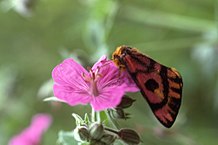You can help expand this article with text translated from the corresponding article in German. (August 2012) Click [show] for important translation instructions.
|
| Hemileuca | |
|---|---|

| |
| Hemileuca eglanterina | |
| Scientific classification | |
| Domain: | Eukaryota |
| Kingdom: | Animalia |
| Phylum: | Arthropoda |
| Class: | Insecta |
| Order: | Lepidoptera |
| Family: | Saturniidae |
| Subfamily: | Hemileucinae |
| Genus: | Hemileuca Walker, 1855 |
| Synonyms | |
| |
Hemileuca is a genus of North American moths in the family Saturniidae first described by Francis Walker in 1855.[1][2] The Finnish University and Research Network[3] currently lists 32 species of the genus. These moths are popular with butterfly collectors because of their variable coloration and wing patterns and their unusual lifestyle, which is an adaptation to the hot and dry habitats where most species live. Most of these moths fly in summer and autumn. The eggs are laid in ring-shaped clusters on stems or branches of the caterpillar's host plants and overwinter. The caterpillars develop to pupation before the hot summer of the following year; most pupate in summer, so that the moths emerge in the cooler late summer and autumn. The stinging hairs of the caterpillars cause a rash when touched. The rash can last from an hour to more than a week. In favorable years, the caterpillars can appear in masses.
- ^ Rougerie, R. & Collective of iBOL Saturniidae expert taxonomists (2009). "Online list of valid and available names of the Saturniidae of the World". Lepidoptera Barcode of Life: Saturniidae.
- ^ Savela, Markku. "Hemileuca Walker, 1855". Lepidoptera and Some Other Life Forms. Retrieved November 9, 2018.
- ^ Finnish University and Research Network. https://ftp.funet.fi/index/Tree_of_life/insecta/lepidoptera/ditrysia/bombycoidea/saturniidae/hemileucinae/hemileuca/. Accessed 8.30.24.